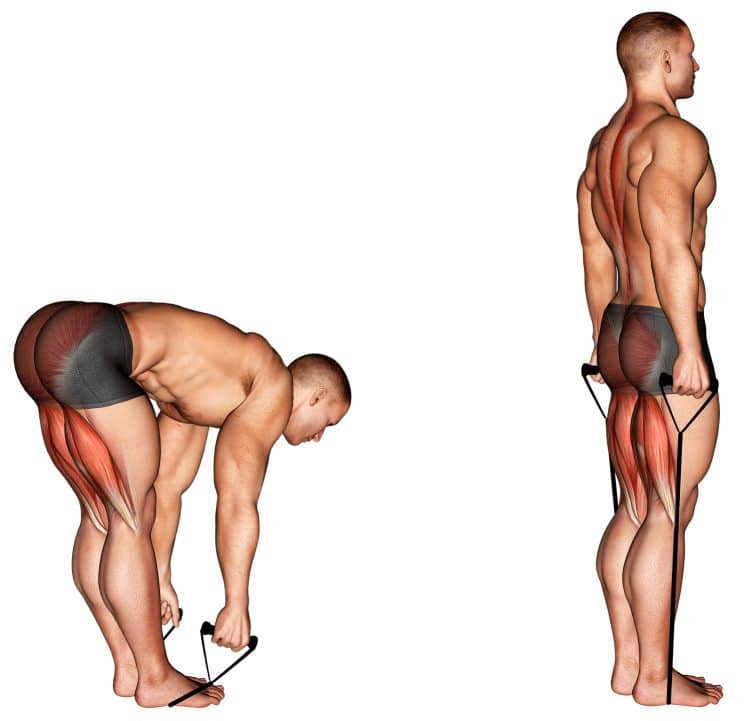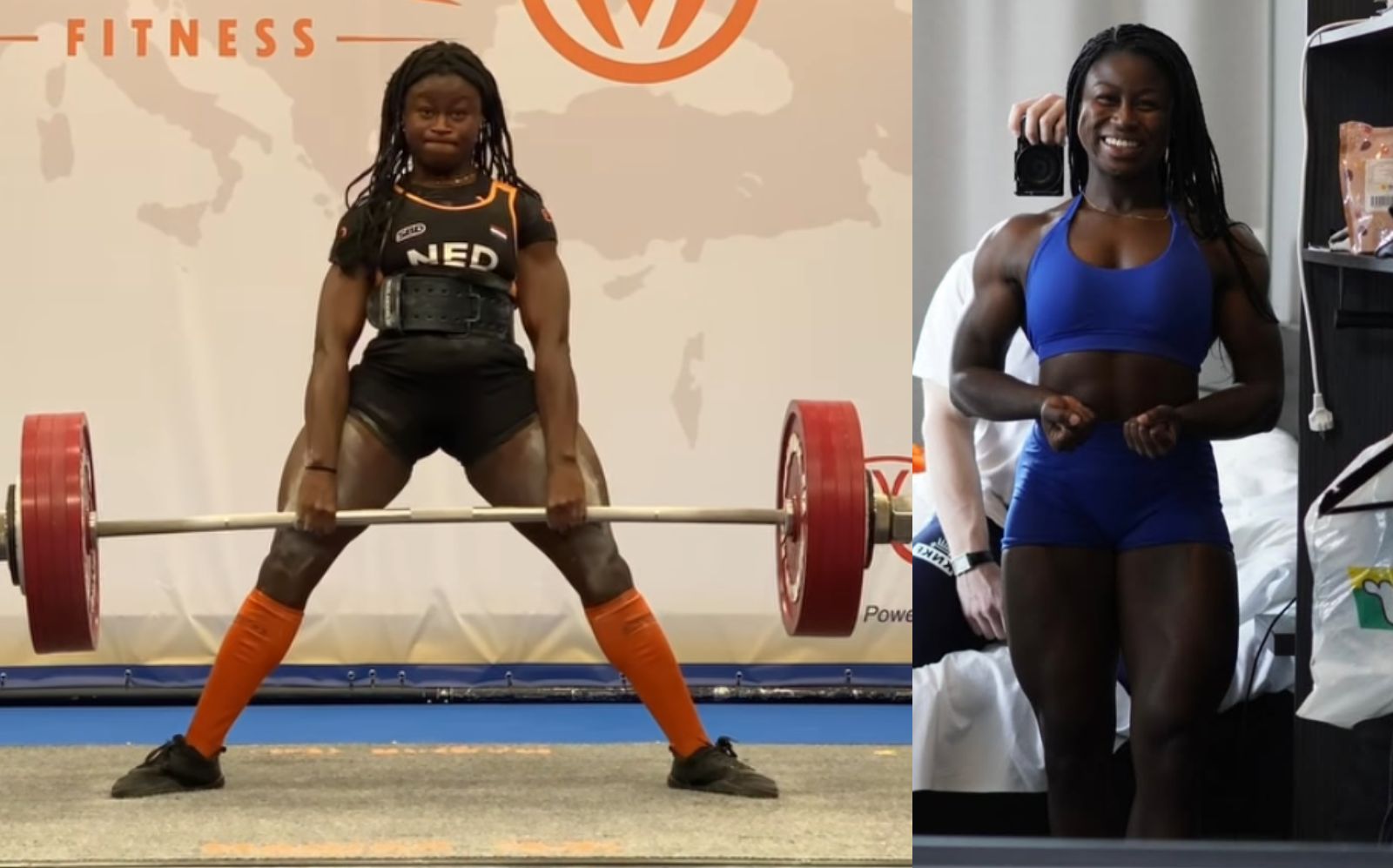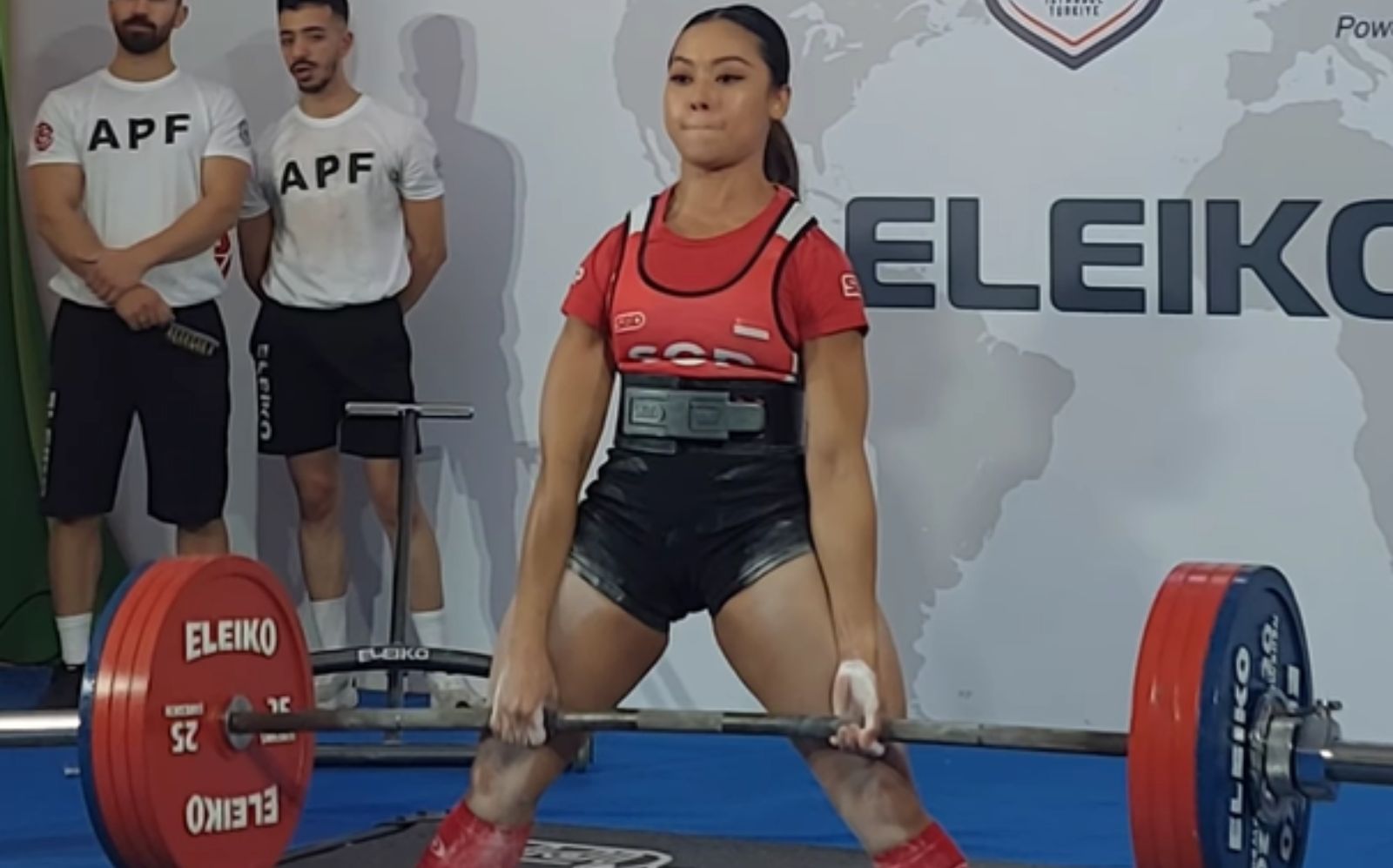Band straight leg deadlifts (BSLDL) are intended as a pull movement alternative to its free weight counterpart based on an old-school technique that emphasizes the stretch and contraction in your rear-facing hamstring thigh muscles. Compared to a conventional deadlift, BSLDLs are more posterior-focused like the Romanian deadlift but can blow up your quads too!
BSDLDs are not what we’d call a beginner movement as it does involve a degree of complexity and training experience both for muscle gain accuracy, strength, and injury prevention.
This guide will focus on the band straight leg deadlift technique, its benefits, common mistakes to avoid, and variations and alternatives.
How To Do The Band Straight Leg Deadlift
Form and weight are going to be crucial when setting up and executing the band straight leg deadlift. Because the legs, as the name suggests, will remain mostly (Not totally) straight which means the hamstrings, and hips are pulling a large portion of the load.
Steps
Now we’ll instruct you on each step in the process of performing a band straight leg deadlift.
Step 1: Setup – Anchor your band to the floor by stepping on it with both feet in a roughly hip width stance. Grab the band with both hands low enough to create tension at the bottom of the movement when you’re bent over.
Level Up Your Fitness: Join our 💪 strong community in Fitness Volt Newsletter. Get daily inspiration, expert-backed workouts, nutrition tips, the latest in strength sports, and the support you need to reach your goals. Subscribe for free!
Step 2: Starting posture – Start from a standing position, and pre-engage your core muscles to stiffen your spine and protect your lower back.
Step 3: Hip hinge – Keeping your legs softly bent, back neutral (Not too rounded or arched) strongly squeeze your midsection then bend forward at the hips as far as you comfortably can. You should feel an incredible stretch in your hamstrings.
Step 4: Drive the hips and glutes – Now contract your hamstrings, squeeze your glutes, and push your hips forward and stand upright, then repeat for the desired number of repetitions.
Tips
- If it’s your first time attempting straight leg deadlifts, start with a lighter to moderate strength band.
- While it’s called a straight leg deadlift, we recommend keeping the knees soft to avoid hyperextending your knees.
- Keep in mind, limb length, and body proportions often affect movement, and muscle activation factors. You may also feel a movement more in one muscle than another while someone else experiences the opposite effect which could change your gains ratios. And training tends to be very individual regardless. Therefore, you should have a clear goal in mind with each movement, and be open to modifying your technique to achieve the desired outcome.
- Similar to the Romanian deadlift (RDL), the band straight leg deadlift should begin from a standing position as the goal is more precision focused.
- Make sure there’s tension in your band at all times during the straight leg deadlift.
This Exercise:
- Target muscle group: Hamstrings, erector spinae
- Type: Hypertrophy
- Mechanics: Isolation
- Equipment: Resistance band
- Difficulty: Intermediate
Muscles Worked During The Band Straight Leg Deadlift
If you want to train all of the muscles on the backside of your body in one shot, band straight leg deadlifts are one way to do that.
Hamstrings
Like the gluteus maximus, hamstrings are said to have three portions, semitendinosus, semimembranosus, and biceps femoris. Hammies are multifunctional at both the hip and knee joints, creating extension, and flexion, respectively.
A properly performed BSLDL should give you one of the best hamstring stretches, and consequently better ham development.
Erector spinae
Considered both part of your spinal and core muscles, erector spinae are as long as the length from your hips to the bumpy bone on the back of your head. They border the vertebral column and when contracted, bring us upright from bent over, and rotate us in either direction.
Straight leg deadlifts are a great erector spinae movement, although you want the brunt of your power coming from the hamstrings.
Adductor magnus
A huge muscle on the inner thigh from the hip bone to the femur, adductor magnus, primarily tasked with pulling the thigh inward when in cahoots with other four leg adductors, can also flex and extend the thigh due to it’s posterolateral fibers.
Gluteus maximus
While your butt is three muscles packed into the hip, your gluteus maximus asserts its dominance as the largest and most powerful of the trio. If you want to lift like a pro, you need a strong tooshie, as it’s a prime hip extender. Not to mention, the aesthetic benefits of heaving a beautifully rounded derrière.
Quadriceps
Some lifters will see improved quadriceps development despite BSLDLs involving high hip positioning, and less knee flexion. Who says the quads can’t benefit from a change of training style?
Having five muscles on the front part of your upper leg, the quadriceps typically help flex the hips and straighten the legs. Crucial muscles to any heavy compound lift, you’ll be happy they’re involved and benefit as the quad muscles contribute hugely to leg strength and mass gains.
Benefits of The Band Straight Leg Deadlift
If you’re unfamiliar with the benefits of training your posterior chain, then this information is for you.
Build a protective layer of eccentric hamstring resilience
Strengthening your hamstrings when the muscle fibers are in a lengthened position can mean the difference between injury and seeing another day at the gym, or competitive surface of choice. Don’t take out word for it though. Research has shown this to be a favorable preventative strategy.
But it makes more sense when you understand the correlation. Sports related hamstring injuries are often due to sudden movements that over stretch your rear facing thigh muscles. Hence if you’ve not properly adapted them to frequent stretching sessions, don’t expect them to hold up to what they weren’t prepared for (1).
Bring your rear up to par
Oftentimes home workouts are more anterior muscle focused, especially if you have limited resources to train with. A heavy band or two can easily fix that. Furthermore, hip hinge variations are must have for optimal strength and muscle development in the glutes, hamstrings, and spinal fibers.
Level Up Your Fitness: Join our 💪 strong community in Fitness Volt Newsletter. Get daily inspiration, expert-backed workouts, nutrition tips, the latest in strength sports, and the support you need to reach your goals. Subscribe for free!
Level up your athleticism
Whether you’re a sports athlete or you just like to take on whatever physical activity that gives you pleasure, you can hardly do too much posterior training. Not only will training the explosive rear muscles give you a competitive edge, but you’ll forge your hamstrings and glutes against injury causing impact.
Great starter movement for learning the hip hinge
Anyone can learn the hip hinge technique, and band straight leg deadlifts are a less intimidating way to do it compared to going to a gym and using free weights. And due to the band’s stretch technology, the movement is easier at the start which is perfect for beginners to ease into it.
Common Mistakes During The Band Straight Leg Deadlift
With lighter loads the risk is less apparent, however, even the smallest poor technique or failure to warmup properly can hurt your back, or tear a muscle. Try to avoid these bad lifting habits.
Maintaining completely straight legs
While the name suggests the legs should be completely straight, few people, unless highly experienced are able to safely lock their knees… and train heavy. The technique, and of course, your level of training should dictate the amount of resistance used. Otherwise, pairing fully straight knees and heavy weight could overstress or hyperextend your knees.
Dangerous back posture
This is especially bad if you have limited training experience and are using heavy near max load resistance that pushes you hard within the first few repetitions. Unless you’re a seasoned lifter and are performing a conventional deadlift in which a rounded back is necessary, you should lift with a mostly neutral but not totally arched back for this variation.
Dumping tension at the bottom
We see this mistake even in video tutorials, and unless done for a specific reason, there should never be slack in the band while performing most banded exercises. The good news is that it’s an easy fix.
Either shorten the band with foot spacing or grip the bands closer to the base, or you can shorten your range of motion.
Variations and Alternatives of The Band Straight Leg Deadlift
These exercises should have a similar effect on the same muscle groups as a band straight leg deadlift. However, alternative exercises can have varying degrees of how much emphasis they put on an individual muscle. For example, while the band straight leg deadlift should heavily work the hamstrings, another movement may engage the glutes more due to the position and technique.
Band unilateral straight leg deadlift
If you’re able to shift any exercise performed on two legs into a one legged movement, you’re going to be experience different benefits. Training one leg at a time requires balance, core control, and total body stability. Not to mention, if you feel there’s a weaker side in a two legged movement, you can use unilateral variations to even out your left to right strength. Single limb movement are typically more functional overall, especially if it’s leg involved.
The key is to perform the movement with identical form to the two leg version.
Steps
- Grab your band in both hands then anchor it down with one foot, ensuring both sides are of even length.
- From the standing position, bend your knees slightly, stiffen your core, then bend at the hips and lean forward onto one leg. Stop when your torso is just above or parallel to the floor.
- To finish, contract your hamstring, squeeze your glutes, then stand back upright.
- Repeat the previous steps for the amount of prescribed repetitions.
Here’s an easy video tutorial on band single stiff leg deadlift.
Freeweight straight leg deadlift
There’s going to be a significant different between a barbell/dumbbell and band straight leg deadlift. And there are pros and cons to both. Free weights allow you to train heavier, and the range of motion is often greater too. Plus, using a barbell will yield consistent resistance from top to bottom unlike bands that must stretch.
Steps
The following video demonstration shows the dumbbell variation of freeweight straight leg deadlifts.
- Grab two dumbbells of the same weight, and begin from a standing position with your feet hip width apart, holding the weight in front of your thighs, arms fully extended.
- Keep a faint bend in your knees, pull your shoulders slightly back but not fully retracted, and stiffen your core.
- Bend at the hips and lean forward until your upper body is slightly above or parallel to the floor. Activate the glutes and pull them forward to stand back upright. Keep the dumbbells close to your body during both phases of the movement.
Check our the following video instructional on the dumbbell straight deadlift.
Cable straight leg deadlift
While cables and bands seems similar, the only thing they share is the variety of positions you can train from. Because cables don’t stretch to create resistance and you can see how much weight you’re lifting too.
Tips
- Slide the pulley low to the bottom of the cable machine to best replicate a deadlift.
- Follow the primary straight leg deadlift instructions above to achieve the same outcome.
Here’s one way you can practice this movement.
Band Romanian deadlift
One of the great hamstring and glute loading deadlift options, band Romanian deadlifts or RDLs, as often called are non-negotiable if you’re going the full posterior training route.
Steps
- Grip your band/s in both hands then step on it evenly with two feet spaced roughly hip width apart.
- Bend your knees slightly, then maintaining a straight back, push your butt back, and fold your upper body forward from your hips until you feel a deep stretch in the hamstrings.
- Squeeze the glutes and extend your hips to stand back up straight. Don’t lean back and arch the back.
Pro tip: The band should be stretched at all times during the band Romanian deadlift.
Related: The 13 Best Romanian Deadlift Alternatives
Banded good morning
The band straight leg deadlift but more erector spinae focused, band good mornings offer more deadlift variety. We recommend using a looped style band for this exercise, like the one shown in the video demonstration below.
Steps
- Step on the band evenly with both feet.
- Squat down and then pull the band up and over top your head and place it on your traps like in a conventional barbell deadlift. You can grab onto the bands next to your chest.
- Starting from a standing position, make a tight midsection the pull your shoulders back.
- With a straight back, reach your hips back, drive your feet into the ground, and lean forward until the hamstrings are adequately stretched.
- Flex the glutes and stand up straight in the starting posture.
- Then simply repeat steps 4 and 5 for the amount of times needed.
Tips
- Don’t over round, or arch your back but rather keep it in a neutral position with your head in the same alignment.
- Avoid hyperextending the back, by standing up straight, and not bending too far backwards.
FAQ’s
How many sets and reps should I do?
While we always encourage a variety of set and rep ranges for best results, and recovery purposes, you need to program band straight leg deadlifts to match your overall goals. Although, your training frequency, and band options should determine your sets and reps.
Generally, we recommend 2-3 sets of an exercise per workout session, and for similar exercises such as band straight leg deadlifts, a rep range between 8-20. Making sure to challenge yourself with enough resistance.
How much resistance do I need to use for best results?
This depends on your goals and strength capabilities.
Beginners can start out with light to medium strength bands while intermediate exercisers should use heavier bands. Once you get the technique down pat, you need to give your muscles a reason to grow and get stronger, otherwise, you’re not doing much.
Therefore, aim for near failure sets in an 8-15 rep range for best results.
Do I need a special type of resistance band?
Not necessarily. But again, it depends how strong you are, and standard bands are typically enough, especially when combined for more resistance.
What's the difference between a band straight leg deadlift and a band deadlift?
Well, there’s a lot of difference between the two. Band deadlifts should mimic a conventional deadlift which involves more knee flexion, and hence quadriceps involvement. In contrast, a band straight leg deadlift should be performed with the knee straighter, and hips higher, which involves less quads and more of the posterior chain and core, plus a smaller range of motion.
Wrapping Up
If there was any confusion as to the straight leg deadlift technique then hopefully it’s a little clearer after reading through this guide. The key takeaway is to keep the knees bent but not too much to ensure you’re engaging the proper muscles, primarily the ones that run the length of your back, optimally. Moreover, if you can safely perform BSLDL with straight knees, you should be very experienced, and know how to choose your weight wisely.
Train within your limitations and, consider lower rep, high intensity sets when you can confidently and properly understand ideal hip hinge technique, and proper joint angles to target the desired muscle groups.
References:
- Raya-Gonzalez J, Castillo D, Clemente FM. Injury prevention of hamstring injuries through exercise interventions. J Sports Med Phys Fitness. 2021 Sep;61(9):1242-1251. doi: 10.23736/S0022-4707.21.11670-6. Epub 2021 Jan 22. PMID: 33480508.
Interested in measuring your progress? Check out our strength standards for Good Morning, Stiff Leg Deadlift, Deadlift, and more.









